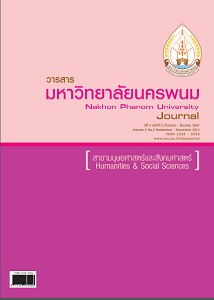การเปรียบเทียบผลสัมฤทธิ์ทางการเรียน เพื่อพัฒนาทักษะด้านฐานสมรรถนะวิชาชีพ เรื่องงานเครื่องยนต์ดีเซล ของนักเรียนสาขาวิชาช่างยนต์ ระดับประกาศนียบัตร วิชาชีพชั้นปีที่ 2 ที่เรียนด้วยบทเรียนสำเร็จรูปร่วมกับบทเรียนสำเร็จรูป ของบริษัทตรีเพชร กับการเรียนแบบปกติ
Main Article Content
บทคัดย่อ
งานวิจัยครั้งนี้มีวัตถุประสงค์เพื่อ 1) ศึกษาประสิทธิภาพการใช้บทเรียนสำเร็จรูป เรื่อง งานเครื่องยนต์ดีเซล ระดับประกาศนียบัตร วิชาชีพชั้นปีที่ 2 ที่มีต่อผลการเรียนรู้ 2) หาค่าดัชนีประสิทธิผลของบทเรียนสำเร็จรูป 3) เปรียบเทียบผลสัมฤทธิ์ทางการเรียนของ นักเรียนที่เรียนด้วยบทเรียนสำเร็จรูปกับการเรียนแบบปกติ 4) เปรียบเทียบผลสัมฤทธิ์ทางการเรียนระหว่างก่อนเรียนและหลังเรียน 5) ศึกษาความพึงพอใจของนักเรียนที่มีต่อการเรียนด้วยบทเรียนสำเร็จรูป กลุ่มตัวอย่าง คือ นักเรียนระดับประกาศนียบัตรวิชาชีพ ชั้นปีที่ 2 จำนวน 50 คน แบ่งเป็นกลุ่มทดลอง จำนวน 25 คน ซึ่งเรียนโดยใช้บทเรียนสำเร็จรูป และกลุ่มควบคุมจำนวน 25 คน ซึ่งเรียน แบบปกติ สุ่มกลุ่มตัวอย่างแบบกลุ่ม เครื่องมือที่ใช้ในการวิจัยได้แก่ บทเรียนสำเร็จรูปที่ใช้ร่วมกับบทเรียนสำเร็จรูปของบริษัทตรีเพชร แบบทดสอบผลสัมฤทธิ์ทางการเรียนมีค่าความยาก ตั้งแต่ 0.33 ถึง 0.80 มีค่าอำนาจจำแนกตั้งแต่ 0.25 ถึง 0.80 และมีความเชื่อมั่น เท่ากับ 0.80 แผนการจัดการเรียนรู้แบบฐานสมรรถนะมีค่าความเชื่อมั่นเท่ากับ 0.90 และแบบสอบถามความพึงพอใจมีค่าความเชื่อมั่น เท่ากับ 0.82 สถิติในการวิเคราะห์ข้อมูล ได้แก่ ค่าเฉลี่ย ส่วนเบี่ยงเบนมาตรฐาน การทดสอบสมมติฐานใช้ t-test ผลการวิจัยพบว่า 1) บทเรียนสำเร็จรูป ประสิทธิภาพเท่ากับ 89.72/88.32 2) ค่าดัชนีประสิทธิผลของบทเรียนสำเร็จรูปเท่ากับ 0.8729 3) นักเรียนกลุ่ม ทดลองมีคะแนนเฉลี่ยผลสัมฤทธิ์ทางการเรียนหลังเรียนสูงกว่าคะแนนก่อนเรียนอย่างมีนัยสำคัญทางสถิติที่ระดับ .05 4) นักเรียนกลุ่ม ทดลองมีผลสัมฤทธิ์ทางการเรียนสูงกว่านักเรียนกลุ่มควบคุม อย่างมีนัยสำคัญทางสถิติที่ระดับ .05 และ 5) ความพึงพอใจของนักเรียนที่ มีต่อบทเรียนสำเร็จรูปโดยภาพรวมอยู่ในระดับมากที่สุด ( = 4.73)
This research aimed to: 1) investigate efficiency of using programmed instruction on diesel engine work at the second year professional certificate level which produces results to students’ learning, 2) examine an effectiveness index of programmed instruction, 3) compare learning achievement of students who learned by programmed instruction with that of those who learned by traditional learning, 4) compare learning achievements between before and after learning, and 5) examine students’ satisfaction with learning through programmed instruction. The sample selected by cluster random sampling was 50 students at the second year professional certificate level who were divided into 2 equal groups of 25. One learned using the programmed instruction, the other using the traditional learning. The instruments used were: a programmed instruction in collaboration with Triphetch Co. Ltd.’s programed instruction; a learning achievement test with difficulty values ranging from 0.33 to 0.80, discrimination power values ranging from 0.25 to 0.80 and a reliability value of 0.80; a competency-based learning management plan with a reliability value of 0.90; and a satisfaction questionnaire with a reliability value of 0.82. Statistics used to analyze data were mean, standard deviation, and t-test for testing a hypothesis. The findings revealed as follows : 1) The programmed instruction had an efficiency index of 89.72/88.32; 2) the value of effectiveness index of the programmed instruction was 0.8729; 3) the treatment group of students had a significantly higher mean score of learning achievement after learning than that before learning at the .05 level; 4) the treatment group of students had a significantly higher learning achievement than the control group of students at the .05 level; and 5) the overall students’ satisfaction with the programmed instruction was at the highest level ( = 4.73).


